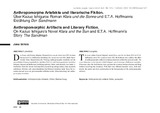Zitierlink:
http://dx.doi.org/10.25819/dedo/127Dateien zu dieser Ressource:
| Datei | Beschreibung | Größe | Format | |
|---|---|---|---|---|
| Scholz_Anthropomorphe_Artefakte_26-33_Dedo5.pdf | 2.22 MB | Adobe PDF |  Öffnen/Anzeigen |
| Dokumentart: | Article | Titel: | Anthropomorphe Artefakte und literarische Fiktion. Über Kazuo Ishiguros Roman Klara und die Sonne und E.T.A. Hoffmanns Erzählung Der Sandmann | Sonstiger Titel: | Anthropomorphic Artifacts and Literary Fiction. On Kazuo Ishiguro’s Novel Klara and the Sun and E.T.A. Hoffmann’s Story The Sandman | AutorInn(en): | Scholz, Jana | Schlagwörter: | Anthropomorphe Artefakte, Fiktion, Wahrnehmung, Anthropomorphic artifacts, fiction, perception | Erscheinungsjahr: | 2022 | Publikationsjahr: | 2022 | Herausgeber: | universi - Universitätsverlag Siegen | Journal: | denkste: puppe / just a bit of: doll (de:do) | Auch erschienen: | denkste: puppe - multidisziplinäre zeitschrift für mensch-puppen-diskurse; Bd. 5 Nr. 1 (2022): Puppen und Puppenfiguren in Narrativen – Themen und Motive in Literatur, Kunst, Theater, Film, Medien, Alltags- und Populärkulturen ; 26-33 | Zusammenfassung: | Das Essay setzt Kazuo Ishiguros Roman Klara und die Sonne von 2021 in einen Bezug zu E.T.A. Hoffmanns Erzählung Der Sandmann von 1816. Beide literarischen Texte thematisieren die Wirkung anthropomorpher Artefakte auf die menschlichen Figuren innerhalb der erzählten Welt. Es wird herausgearbeitet, inwiefern Ishiguros Roman auf Hoffmanns Erzählung referiert. Dabei wird deutlich, dass beide literarischen Texte die Grenze zwischen Mensch und Ding infrage stellen, ohne sie jedoch aufzulösen. Mit den sehr unterschiedlichen Erzählweisen beziehen beide Texte die Lesenden ein und lassen sie gewissermaßen teilhaben an der ‚Menschwerdung‘ der anthropomorphen Artefakte. The essay relates Kazuo Ishiguro’s novel Klara and the Sun from 2021 to E.T.A. Hoffmann’s story The Sandman from 1816. Both literary texts address the effect of anthropomorphic artifacts on human characters within the narrated world. The essay elaborates on the extent to which Ishiguro’s novel references Hoffmann’s narrative. It becomes clear that both literary texts question the boundary between human and thing without dissolving this boundary. With their very different narrative styles, both texts involve the reader and allow participation in the humanization of the anthropomorphic artifacts. |
DOI: | http://dx.doi.org/10.25819/dedo/127 | URN: | urn:nbn:de:hbz:467-24080 | URI: | https://dedo.ub.uni-siegen.de/index.php/de_do/article/view/127 https://dspace.ub.uni-siegen.de/handle/ubsi/2408 |
Lizenz: | http://creativecommons.org/licenses/by-sa/4.0/ |
| Enthalten in den Sammlungen: | universi - Zeitschriftenartikel |
Diese Ressource ist urheberrechtlich geschützt. |
Seitenansichten
216
checked on 02.04.2025
Download(s)
172
checked on 02.04.2025
Google ScholarTM
Prüfe
Prüfe
Diese Ressource wurde unter folgender Copyright-Bestimmung veröffentlicht: Lizenz von Creative Commons


